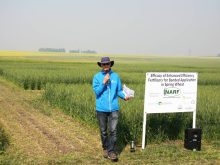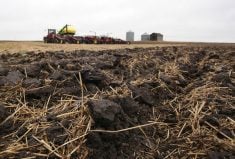Propane burns better | More power translates into less diesel fuel and cleaner burning equipment
BRANDON — Diesel engines need extra help working under full load, which is all of the time for combines and 75 percent of the time for tractors.
Conventional engineering uses the turbocharger to help the engine produce extra power.
However, Maxquip from Alberta has developed technology to enhance the turbo boost with propane.
DieselFlex, its diesel-propane injection system, injects propane vapour into the incoming fresh air stream after the air cleaner and before the turbo intake. The original diesel pump and injectors continue to function as usual, whether or not propane is blended into the combustion chamber.
Read Also

Short rapeseed crop may put China in a bind
Industry thinks China’s rapeseed crop is way smaller than the official government estimate. The country’s canola imports will also be down, so there will be a lot of unmet demand.
MaxQuip said its propane injection system increases available horsepower by 20 to 25 percent while reducing overall fuel consumption by 10 to 15 percent.
The company said pumping propane into a diesel engine works because diesel fuel generally does not burn completely in the combustion chamber.
As a result, oxygen and unburned diesel particulate go up the stack as smoke, which represents wasted energy.
The smoke is also a visual indication that pollutants are going into the atmosphere.
Propane molecules are smaller than diesel molecules so they burn more efficiently, causing the diesel molecules in the combustion flash to also burn more efficiently.
Injecting the right volume of propane into the combustion chamber at the right time causes the combustion process to create more power. More power translates into a reduced need for diesel fuel.
The side effect is lower particulate emissions in the exhaust, said Maxquip representative Lance Hartman.
“We’re seeing the biggest DieselFlex benefit in the ag sector be-cause these engines are running so close to full load for extended periods,” said Hartman.
“Our tests show that engine oil stays cleaner with the addition of propane, simply because the blended fuel burns more efficiently. There are fewer hydrocarbons left in the combustion chamber. That should translate into lower maintenance costs and longer engine life.
“We hear comments from farmers that it’s hard for them to see their equipment out in big fields if it’s got DieselFlex. When the propane is running, the particulate matter and black smoke disappear. There’s no visible trace of where the machine might be.”
He said working the engine harder does not push it to the point of black smoke. When the engine works harder, the turbo also works harder, which signals the DieselFlex controller to increase the propane flow.
Hartman said adding propane to a diesel engine is no easy feat because propane is difficult to ignite unless the propane-air ratio is perfect.
The ignition point is also touchy. Propane won’t self ignite under extreme pressure, such as the 20:1 compression ratio typically found in a diesel combustion chamber. Propane needs a spark or an external source of ignition to get it going.
The propane is injected into the airstream before the intercooler, where it is cooled. It’s then forced into the combustion chamber on the intake stroke.
The diesel fuel ignites as usual on the combustion stroke, and the propane vapour molecules ignite slightly after the diesel.
“We often have guys ask us if we can compress the propane vapour so it can be injected into the combustion chamber instead of into the airflow,” he said.
“But that would defeat the purpose. If you compress propane, it turns back into a liquid. We need the propane to be a vapour if it’s going to burn all unused diesel in the combustion chamber.”
Hartman said new diesel engines have a lot of low-end torque. They don’t use much of the turbocharger if they’re not under load. If they don’t use it, then the DieselFlex sensors will not trigger the propane injection system.
“That’s especially true in highway rigs,” he said.
“If a truck is running empty, the engines today have enough torque to propel themselves down the road without the turbo. So if they’re running our DieselFlex system, that also means they’re not getting the benefit of propane when the engine isn’t pulling hard. Our alternative fuels division is trying to put just a little propane into the airflow, even when an engine isn’t under load, so the owner can benefit from having the DieselFlex in all conditions.”
Maxquip was one of the first companies to introduce multi-fuel systems so that gasoline-powered cars could run on either gasoline or propane.
However, those vehicles ran on either one or the other. They could not blend gasoline with propane.
Hartman said automobile technology allowed Maxquip to move into a true blended fuel system with propane and diesel.
In fact, the special injectors that the company developed for gasoline engines are the same injectors now used in the DieselFlex system to pump propane into the fresh air flow.
“All the DieselFlex kits we have now are for pre-DEF engines, but it’s obvious that DieselFlex can do some of the work of DEF,” he said.
“We don’t know for sure yet if DieselFlex can totally replace DEF, but it certainly can reduce the amount of DEF that’s needed.”
Hartman said the retail price of DieselFlex kits varies, depending on the vehicle. Highway tractors are considerably more expensive than farm machines because of their complexity. Most kits start at about $6,000.
For more information, contact Maxquip at 866-629-7847 or visit www.maxquip.ca.
















